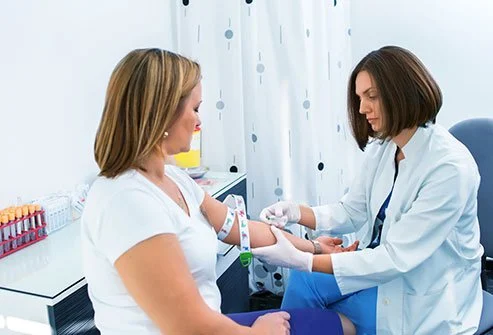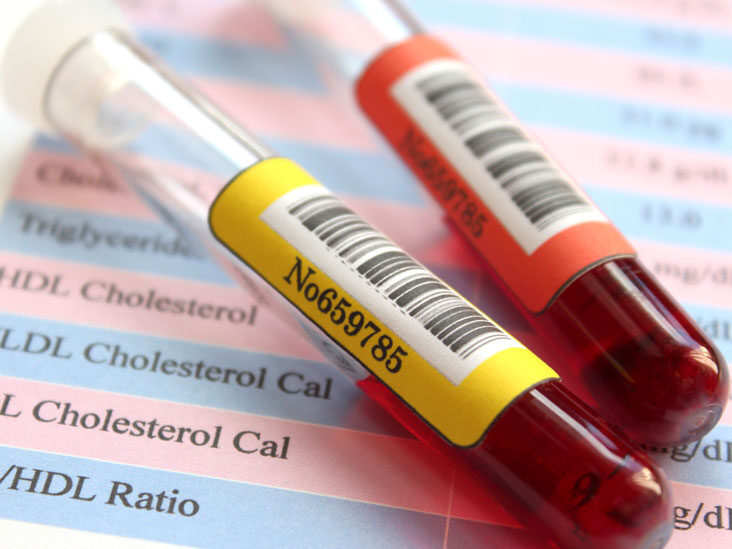
Cholesterol levels should be measured at least once every 5 years for everyone over the age of 20. The screening test that is usually done is a blood test called a lipid profile. Experts recommend that men age 35 and older and women age 45 and older be screened more often for lipid disorders. The lipoprotein profile includes:
Total cholesterol
LDL, low-density lipoprotein cholesterol, also called “bad” cholesterol
HDL, high-density lipoprotein cholesterol, or “good” cholesterol
Triglycerides are fats carried in the blood from the food we eat. Excess calories, alcohol, or sugar are turned into triglycerides and stored in fat cells throughout the body.
The results of your blood test will come in the form of numbers. Here’s how to interpret your cholesterol numbers.
The first thing you need to know is that numbers alone are not enough to predict your risk of heart problems or to determine what you need to do to reduce your risk.
They are just one part of a larger equation that includes your age, blood pressure, smoking, and use of blood pressure medication. Your doctor will use this information to calculate your 10-year risk of serious heart problems.
The more risk factors you have, the higher your risk of heart problems and stroke. Taking steps to reduce any of these risks, including lowering your cholesterol, can also help reduce other risk factors you have.
Together with your doctor, you will develop a strategy to reduce your risks.
LDL cholesterol
LDL cholesterol can build up on the walls of your arteries and increase your chances of heart disease. That is why LDL cholesterol is referred to as “bad” cholesterol. The lower your LDL cholesterol number, the lower your risk.
If your LDL is 190 or more, it is considered very high. Your doctor will most likely recommend a statin in addition to making healthy lifestyle choices. Statins are drugs that can help lower cholesterol.
You may need to take a statin even if your LDL is below 190. After evaluating your 10-year risk, your doctor will recommend a percentage by which you should try to lower your LDL through diet, exercise, and medication, if necessary.
HDL cholesterol
When it comes to HDL cholesterol – the “good” cholesterol – a higher number means a lower risk. HDL cholesterol protects against heart disease by removing “bad” cholesterol from the blood and preventing its accumulation in the arteries. A statin can slightly raise your HDL, as can exercise.
Triglycerides
Triglycerides are the form in which most fat is found in food and the body. A high level of triglycerides is associated with a higher risk of coronary artery disease. Here is the breakdown.
Triglycerides Category of triglycerides
Less than 150 Normal
150 – 199 Slightly tall
200 – 499 High
500 or higher Very high
When you have high levels of triglycerides, there is a good chance that you also have low levels of HDL “good” cholesterol and high levels of LDL “bad” cholesterol. This combination increases your chances of having a heart attack or stroke. Here’s the good news: Many medications that treat abnormal cholesterol levels also help lower high triglycerides.
Your doctor may recommend that you also take other medications, such as pills to lower blood pressure and the risk of heart disease, stroke, and diabetes. If your triglycerides are very high — above 500 mg/dL — you may also be given medicine to lower them.
Total cholesterol
Your total blood cholesterol is a measure of LDL cholesterol, HDL cholesterol, and other lipid components. Your doctor will use your total cholesterol number when determining your risk of heart disease and how best to manage it.
Why is cholesterol important for our body?
Every cell in the body needs cholesterol to help cell membranes form layers. These layers protect the contents of the cell by acting as a gatekeeper to what can enter or leave the cell. It is made in the liver, and the liver also uses it to make bile, which helps you digest food. Cholesterol is also needed to make certain hormones and to produce vitamin D. Your liver makes enough cholesterol to meet your body’s needs for these important functions.
What are the types of cholesterol?
Cholesterol moves throughout the body using lipoproteins in the blood. These lipoproteins include:
Low-density lipoprotein (LDL) is one of the two major lipoproteins. LDL is often called “bad cholesterol”.
Another major lipoprotein is high-density lipoprotein (HDL). HDL is often called “good cholesterol”.
Very low-density lipoproteins (VLDL) are particles in the blood that carry triglycerides.
If cholesterol is essential, why do we need to worry about how much we have?
It is important to have enough cholesterol to meet your needs. Too much cholesterol can cause problems. If your cholesterol levels are high, the condition is called hyperlipidemia. If your cholesterol levels are low, the condition is called hypolipidemia. It is not common to have very low cholesterol levels, but it can happen.
What is low-density lipoprotein (LDL)?
You might think it’s strange that low-density lipoprotein is called bad cholesterol when we keep hearing about how we should lower our cholesterol. However, LDL is “bad” because of what it does.
LDL can build up on the walls of your arteries and narrow them. Fatty deposits form plaque that lines your arteries and can cause blockages. This buildup is called atherosclerosis.
Arteries are blood vessels that carry oxygen-rich blood from the heart to all other organs in the body.
The fats associated with LDL cholesterol levels and the ones you should minimize in your diet are called saturated fats and trans fats. Saturated fats are solid or waxy when at room temperature. Saturated fats are mostly found in products that come from animals, such as meat, milk, cheese, and butter.
Trans fats are created when liquid fats are subjected to a hydrogenation process to become solid. Trans fats are found in fast foods and fried foods and are used to extend the shelf life of processed foods such as cookies, crackers, and baked goods.
What is high-density lipoprotein (HDL)?
HDL is called “good cholesterol”. It’s good because it moves other types of cholesterol (including LDL) away from the arteries. It might help to think of HDL as a delivery truck and LDL as a dump truck. HDL lowers other types of cholesterol in the liver so it can be removed from the body. Higher levels of HDL are thought to reduce the risk of heart disease.
What kind of test measures cholesterol?
Everyone over the age of 20 should have their cholesterol measured at least once every five years. Your healthcare provider will order a blood test to show how much cholesterol is being carried in your bloodstream. This test will show you your cholesterol level. Your provider may also order what is called a lipid panel or lipid profile. The panel will give you the following numbers:
Total cholesterol.
LDL levels.
HDL levels.
VLDL and triglyceride levels.
Non-HDL cholesterol.
The ratio between cholesterol and HDL.
There are advanced tests that will analyze the size and shape of LDL cholesterol levels and also give the number of LDL particles, but these are not normally ordered. Some test-makers say more advanced tests better indicate who is at risk for heart disease, but most providers still believe routine tests are sufficient.
How is total cholesterol or blood cholesterol test performed?
A blood test is a routine test. A phlebotomist is a person whose job is to draw blood. Blood is usually taken from a vein in the arm. You sit down and the phlebotomist wraps a rubber band around your upper arm so that the vein in your elbow protrudes. They then use a needle to puncture the vein and remove the blood. The blood is sent to a laboratory for examination.

You’ve probably been to health fairs where testing is offered. In this case, the person performing the test will take a drop of blood from your finger. The stick test uses a small blade to poke a hole in the tip of your finger to draw blood.
How do you prepare for a cholesterol test?
In most cases, you will need to fast for nine to 12 hours before the test. Make sure you tell the person taking your blood how long it’s been since you ate or drank anything other than water.
There are some cases where a cholesterol test is done without fasting. This applies to tests carried out during medical examinations and may apply to people under the age of 20 or to people who are unable to fast.
Some medical societies believe that fasting is not necessary to get a true picture of blood lipid levels, while other associations believe that fasting provides a better idea of a person’s heart disease risk. Before you go for a blood test, you should be clear about whether you need to fast and for how long.
How long does it take to get cholesterol test results?
Your results will often be available within a day or two. In the case of screenings and finger tests, you get the results immediately. In either case, you’ll want to talk to your healthcare provider to discuss the results. Results are often reported in milligrams per deciliter (mg/dL).
